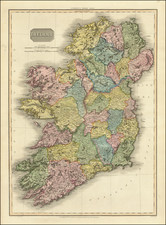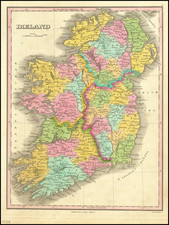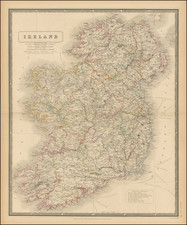The First Map of Ireland Published in Italy
Rare early Lafreri School map of Ireland, published in Italy about 1560.
The map is oriented with south at the top, with a small portion of the Scottish coast shown at the top left.
This highly important map depicts all of Ireland, with its forests, rivers and mountains, all expressed through beautiful Italian Late Renaissance engraving. The overall shape of the island remains configured in the classic early Potato shape similar to George Lilly's 1546 map of the British Isles, but with noteworthy improvements. Almagia commented that the southern part of the island appears here more narrow in the west-east direction, and the mountainous areas have been reworked, but the hydrography and location of towns are very similar.
The map features numerous places (names familiar to the modern viewer), including Dublimim (Dublin), Kilcone (Kilkenny), Waterfordia, Drodad (Drogheda), Limiricum (Limerick), Dondal (Dundalk), Arglas (Ardglas), Armacana (Armagh)and Galuia (Galway). Belfast (?) is shown with a large building, but is unnamed.
Perhaps the most curious aspect of the map is the inclusion of 'Purgatorium S. Patrictii', ('St. Patrick's Purgatory'), shown in the north of Ireland. According to legend, during the 5th Century A.D., on an island in Lough Derg (County Donegal), St. Patrick, the patron saint of Ireland, was visited by Christ, who showed him a cave that was the entrance to Purgatory. The site, known as Station Island, was mentioned in texts as early as 1185 and became an important pilgrimage site in Medieval times. It appeared on maps during the early 15th Century and was the only Irish location noted on Martin Behaim's famous globe of 1492.
Although the present map was clearly made by a member of the 'Lafreri School' of cartographers, its authorship is not known. Bonar Law attributed the map to Ferrando Bertelli based upon its typography and dated the map 1560, but the image he used for comparison in his boo was in fact a map by Camocio. Tooley also believed the map to be by Bertelli, but without having seen the map. Bifolco notes that additional evidence of Bertelli's authorship can be found in the copy of the map bound into an atlas at the University of Helsinki.
Rarity
The map is extremely rare. We note only 2 appearances at auction and 1 in a dealer catalog (this examples) over the past 30 years.










![[ Ireland ] Hiberniae Regnum tam in praecipuas Ultoniae, Connaciae, Lageniae, et Momoniae. . .](https://storage.googleapis.com/raremaps/img/small/78023.jpg)


![[Siege of Dunboy] Bere Island](https://storage.googleapis.com/raremaps/img/small/83706.jpg)
![[Northwest Ireland] De West-Cust van Yerlandt tusschen C. Tellin en Slijnehooft](https://storage.googleapis.com/raremaps/img/small/75344.jpg)